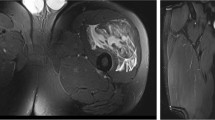Abstract
Prognostication of quadriceps contusion is based on the patient’s active knee flexion after the injury. Unlike ultrasonography, clinical grading does not define the extent of soft tissue injury and may provide inaccurate time for return to play. The purposes of this report are to describe the ultrasound findings of the different clinical grading of quadriceps contusion and document the return to play of each case. Seven patients were evaluated in this series. Results showed discrepancies in the disability time between clinical grading and ultrasound findings. Clinical grading did not consistently estimate the return to play as described in previously published literature. Contusions with hyperechoic lesions had earlier return to play compared to patients with hypoechoic findings. Contusions with hypoechoic lesions might require aggressive monitoring and therapy to decrease disability time and avoid complications such as myositis ossificans.




Similar content being viewed by others
References
Trojan TH. Muscle contusion (Thigh). Clin Sports Med. 2013;32:317–24.
Jackson DW, Feagin JA. Quadriceps contusions in young athletes: relation of severity of injury to treatment and prognosis. J Bone Jt Surg Am. 1973;55A:95–105.
Ryan JB, Wheeler JH, Hopkinson WJ, et al. Quadriceps contusion: west point update. Am J Sports Med. 1991;19–3:299–304.
McMillan S, Busconi B, Montano M. Hip and thigh contusions and sprain. In: Miller MD, Thompson SR, editors. Delee & Drez’s orthopedic sports medicine: principles and practice. Philadelphia: Elsevier Saunders; 2015. p. 1007.
Alonso A, Hekeik P, Adams R. Predicting recovery time from the initial assessment of a quadriceps contusion injury. Aust J Physiother. 2000;46:167–77.
Aspelin P, Ekberg O, Tjorsson O, et al. Ultrasound examination of the lower limb in athletes. Am J Sports Med. 1992;20:601–3.
Guillodo Y, Bouttier R, Saraux A. Value of sonography combined with clinical assessment to evaluate muscle injury severity in athletes. J Athl Train. 2011;46:500–4.
Lee JC, Mitchell AWM, Healy JC. Imaging of muscle injury in the elite athlete. Br J Radiol. 2012;85:1173–85.
Pasta G, Nanni G, Molini L, et al. Sonography of the quadriceps muscle: examination technique, normal anatomy, and traumatic lesions. J Ultrasound. 2010;13:76–84.
Johnson MB, Grainger AJ. Muscle injury and sequelae. In: Pope T, Bloem HL, Beltran J, Morrison WB, Wilson DJ, editors. Musculoskeletal imaging. Philadelphia: Elsevier Saunders; 2015. p. 620.
Alanen A, Kormano M. Correlation of the echogenicity and structure of clotted blood. J Ultrasound Med. 1985;4:421–5.
Draghi F, Zacchino M, Canepari M, et al. Muscle injuries: ultrasound evaluation in the acute phase. J Ultrasound. 2013;16:209–14.
Conforti M. The treatment of muscle hematomas, muscle injuries in sport medicine. In: Bisciotti GN, editor. InTech. 2013. doi:10.5772/56903. https://www.intechopen.com/books/muscle-injuries-in-sport-medicine/the-treatment-of-muscle-hematomas.
Author information
Authors and Affiliations
Corresponding author
Ethics declarations
Ethical statement
All procedures followed were in accordance with the ethical standards of the responsible committee on human experimentation (institutional and national) and with the Helsinki Declaration of 1964 and later versions. Informed consent was obtained from all patients being included in the study.
Conflict of interest
Rolando Junior Torres, Yuki Kato and Shin Yamada declare no conflict of interest. Soichi Hattori receives honorarium and non-financial support from Konica Minolta and Sygmax while Hiroshi Ohuchi receives honorarium and non-financial support from GE.
About this article
Cite this article
Torres, R.J.L., Hattori, S., Kato, Y. et al. Ultrasonography and return to play of the different clinical grading of quadriceps contusions: a case series. J Med Ultrasonics 45, 375–380 (2018). https://doi.org/10.1007/s10396-017-0833-2
Received:
Accepted:
Published:
Issue Date:
DOI: https://doi.org/10.1007/s10396-017-0833-2




